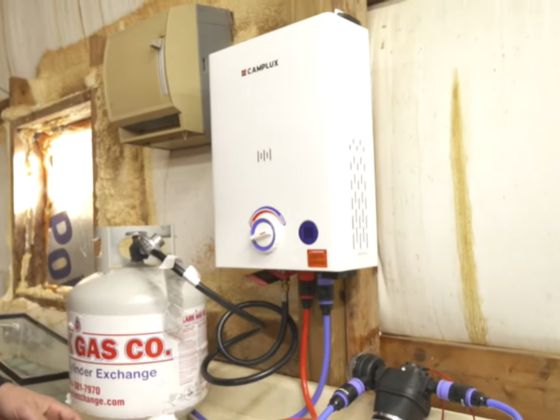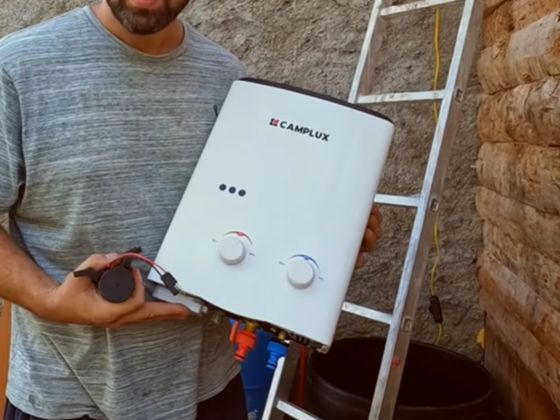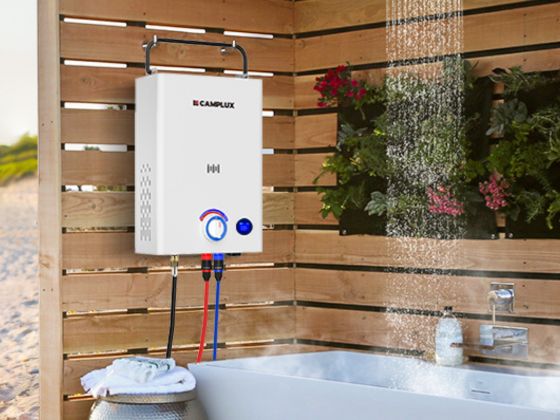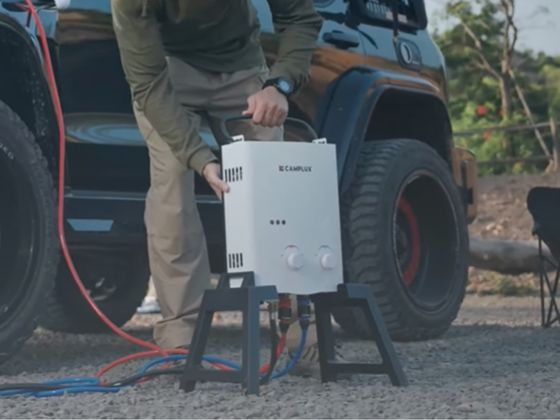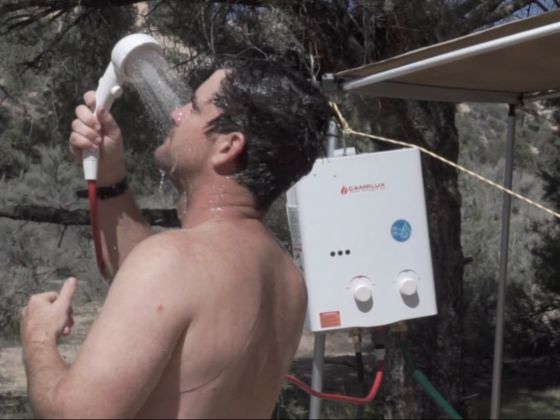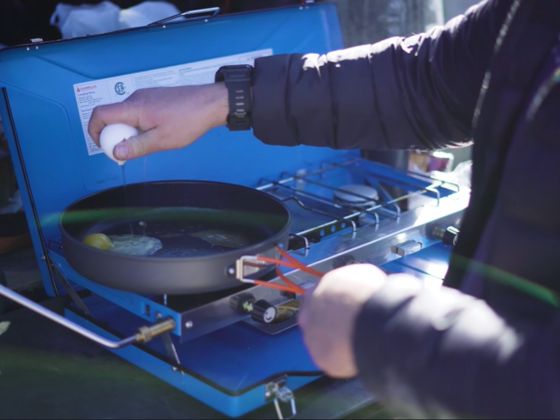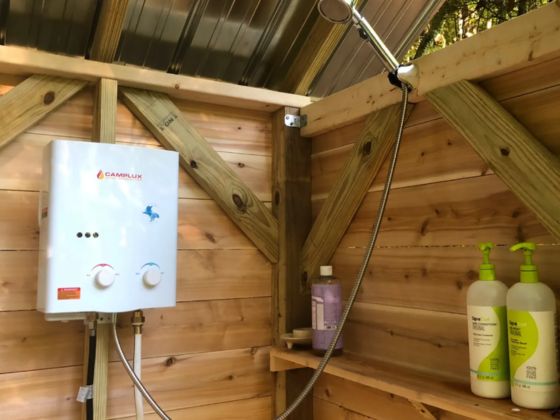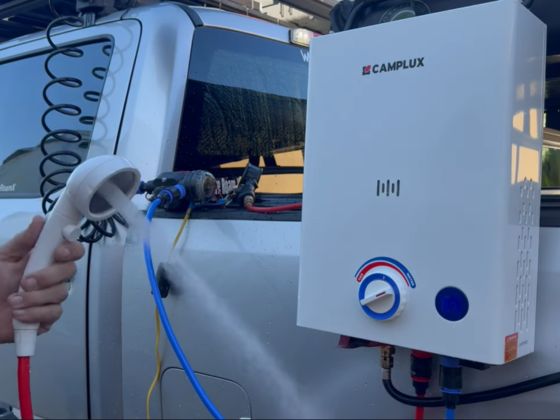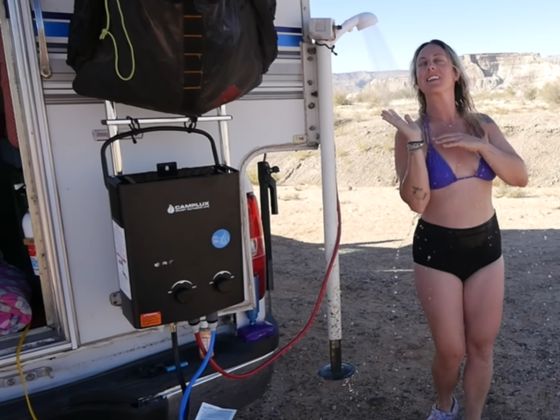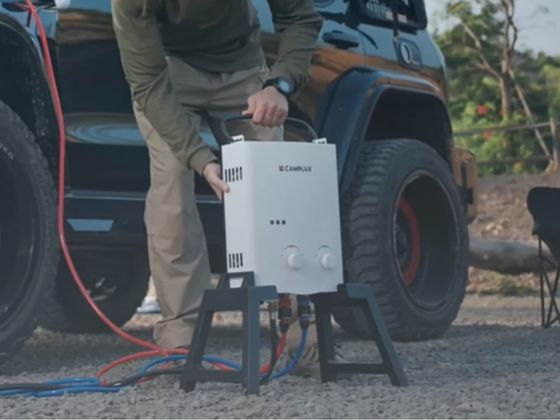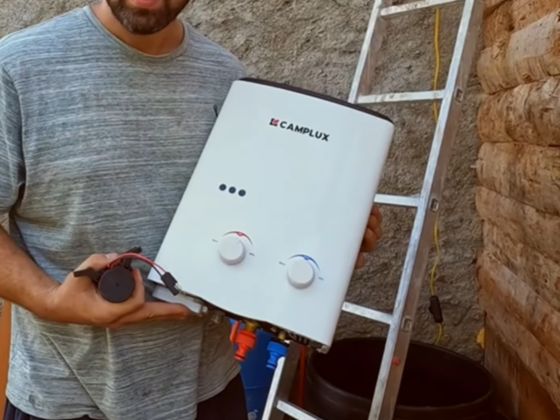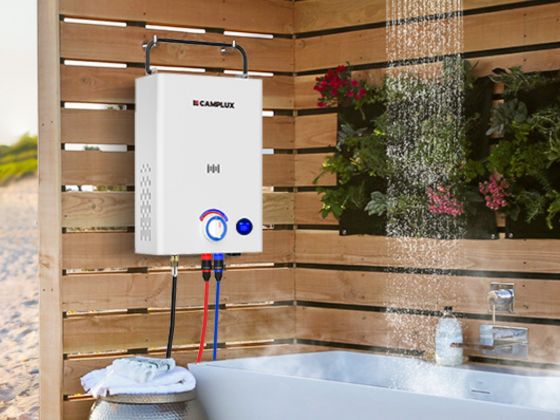TL;DR
Portable outdoor gas water heaters can be very energy efficient when you size them correctly, set a sensible outlet temperature, and run them "on demand" (no pilot flame burning away). Choose a unit with a modulating burner, use a low-flow shower head (around 4–6 L/min), keep your hose runs short, and shut the water off while you're soaping up. Do those basics and you'll stretch your LPG much further—without sacrificing comfort.
Note: In Australia, we talk about heater output using MJ/h and flow using L/min. All examples below stay comfortably within typical portable-heater specs.
1) Energy efficiency 101: how to judge a portable hot water system
If you're new to camping water heaters, a few specs tell you most of what you need to know about energy use:
-
Rated heat input (MJ/h): How much gas energy the burner can draw per hour at full tilt. A higher figure means more heating capacity—but also more potential gas consumption if you run it flat out.
-
Thermal efficiency (%): How much of that gas energy actually makes it into your water. Better design and clean heat-exchange surfaces = less waste.
-
Rated flow (L/min) at a given temperature rise (ΔT): You'll often see something like "6 L/min at 25 °C rise". That means the unit can lift incoming water by 25 °C at that flow rate.
-
Low start pressure/flow: A heater that fires with low water pressure lets you use gentler flow rates—great for saving water and LPG at bush camps.
Unlike big fixed household systems, truly portable units don't always carry the same star-rating labels. That's fine—your real-world efficiency comes down to the combo of hardware design and how you use it.
2) Design features that genuinely save gas
Not all outdoor heaters are built the same. Look for these cues if you care about stretching your bottle:
-
Modulating burner (auto flame control): Instead of blasting maximum flame and forcing you to mix in cold water, a modulating burner dials the flame to match your set temperature and flow. That avoids the "hot-then-cold" shuffle and cuts gas waste.
-
Electronic ignition, no pilot light: With a spark ignition that lights only when water flows, you're not burning gas idling away between showers.
-
Efficient heat exchanger: Good surface area and corrosion-resistant materials transfer heat better and keep performance steadier over time.
-
Clear temperature and seasonal settings: Knobs you can read (even with cold hands) and a winter/summer mode help you hit your target outlet temperature instead of overshooting.
-
Low-flow shower head / aerator: Dropping from, say, 9 L/min to ~5 L/min reduces the volume you need to heat. Less water heated = less gas used. Comfort can still be excellent with the right spray pattern.
-
Built-in protections (over-temp, flame-out, dry-burn): Safety first—plus they prevent abnormal conditions that can chew through gas or damage components.
3) Habits that move the needle (simple, practical, Aussie-proof)
You don't need to be an engineer to save gas. Try this:
-
Set a sensible outlet temperature: Aim for ~38–42 °C for showers. If you set it there, you won't need to cool scalding water with cold—classic efficiency killer.
-
Use water in bursts: Wet down, turn off to soap/shampoo, then rinse. Most modern units relight instantly when flow resumes.
-
Start at 4–6 L/min: It's the sweet spot for comfort + savings for a single shower at camp.
-
Keep hoses short and out of the wind: Shorter runs and less exposure mean less heat lost before the water even hits you.
-
Pre-filter and de-scale: A small mesh filter on the inlet keeps grit out; periodic de-scaling maintains heat-transfer efficiency—especially important with hard/boar water.
-
Ventilation matters: Clean air in and exhaust out leads to more complete combustion, better efficiency, and safer operation.
Little tweaks add up. A few weekends of mindful use and you'll notice your 9 kg bottle lasting longer.

4) Right-sizing: "big" isn't always "best"
Picking the right L/min rating is half the game:
-
5–6 L/min: Solo showers, washing up, compact camp setups. This is where you'll get eye-opening efficiency.
-
8–10 L/min: Couples or families taking turns, slightly higher comfort margin. Still very manageable on gas if you set temperature and flow sensibly.
-
12 L/min and above: Higher demand (multiple rinses back-to-back, chilly mornings where you want more heat headroom). Efficient for the right scenario, but only if you actually need the extra flow/ΔT.
The trap: Over-sizing. If you buy a high-flow unit then run it at a trickle with the temperature set too hot, you'll end up blending with cold, cycling the burner, and wasting gas. Buy for your real use—people count, typical inlet water temp, and how long your showers usually go.
Quick selector (rule-of-thumb):
-
Two adults, coastal autumn, quick rinses: 5–6 L/min is plenty.
-
Family of three, alternating showers in spring: 8–10 L/min keeps the queue moving.
-
Alpine shoulder season, pre-dawn starts: Consider a higher-flow model for comfortable ΔT and shorter warm-up—then still run moderate flow during the shower.
5) What does a shower actually cost in gas?
Let's make it tangible. Propane (LPG) is energy-dense. A 9 kg bottle contains roughly ~440–450 MJ of chemical energy. A 4.5 kg bottle contains about half that. How much of it you use per shower depends on flow, time, and how much you're lifting the water temperature (ΔT).
Some handy physics (kept simple):
-
Heating 1 L of water by 1 °C takes about 4.18 kJ (0.00418 MJ).
-
So, if you heat 30 L of water by 25 °C (e.g., from 15 °C to ~40 °C), that's ~3.1 MJ delivered into the water.
-
If your heater is, say, 80–85% efficient, the gas energy you need is roughly 3.6–3.9 MJ for that shower.
Now a couple of realistic scenarios:
Efficient shower (solo camper)
-
Flow: 6 L/min
-
Time: 5 min (30 L total)
-
ΔT: 25 °C (typical coastal evening)
-
Energy into water: ~3.1 MJ
-
Gas required at 82% efficiency: ~3.8 MJ
-
Showers per 9 kg bottle (~445 MJ): ~115 (best-case use pattern)
Comfort shower (after a muddy hike)
-
Flow: 9 L/min
-
Time: 8 min (72 L total)
-
ΔT: 30 °C (chilly morning)
-
Energy into water: ~9.0 MJ
-
Gas required at 82% efficiency: ~11.0 MJ
-
Showers per 9 kg bottle: ~40
Real life lands between those numbers. Wind, longer hoses, higher set temperature, and colder inlet water will nudge consumption up. But even with a comfortable rinse, getting ~30–50 showers from a 9 kg bottle is achievable with sensible settings and on-off technique.
What about dollars? Bottle swap prices vary by state and servo. If your 9 kg swap costs, say, A$35:
-
Efficient pattern (~3.8 MJ/shower): ~A$0.30 per shower
-
Comfortable pattern (~11 MJ/shower): ~A$0.90 per shower
Your exact costs will vary with local pricing, but that gives a feel for the order of magnitude. The biggest lever you control is flow × time × set temperature.

6) Greener by design: saving gas also saves water (and emissions)
-
On-demand heating means you burn gas only when water flows, unlike pre-heating a big tank.
-
Lower flow + sensible temps cut both LPG use and water use—critical at remote camps with limited supply.
-
Off-grid friendly setups: Pair a portable gas heater with a small 12 V water pump and, where relevant, solar-charged power for the pump. You get hot water without leaning on a big generator.
-
Do the right thing by the bush: Use biodegradable soaps and follow campsite rules for grey water. Efficiency isn't just about fuel—it's about leaving the place as you found it.
7) Australia-specific tips (coast, high country, outback)
Coastal & high-salt areas
-
Rinse the exterior and fittings with fresh water after salty trips.
-
Consider protective storage and a quick wipe-down to keep heat-exchange surfaces and vents clean. Salt and grit can hamper airflow and combustion.
-
Expect a larger temperature rise (ΔT). Instead of cranking the flame to maximum, reduce flow slightly to allow the heater to reach your set outlet temperature efficiently.
-
Use winter mode if your unit offers it, and drain the heater after use to prevent freeze damage overnight in shoulder seasons.
Dry, hot inland
-
Inlet water may already be warm in the afternoon. Take advantage: dial the outlet temperature a few degrees lower and enjoy notably lower gas use.
-
Shade the heater and shorten hose runs so you aren't fighting hot wind or unnecessary heat loss.
Caravans & camper trailers
-
Mount securely, keep clearances around air inlets and exhaust, and check quick-connect fittings for dust caps so grit doesn't foul the gas line or water inlet.
-
Plan your bottle size (4.5 kg vs 9 kg) around trip length and shower habits; it's often better to adjust habits than carry extra weight.
8) Maintenance = efficiency you can feel
A clean, well-maintained heater runs hotter on less gas:
-
Clean the inlet strainer regularly: Sediment and sand reduce flow and force the burner to work harder.
-
De-scale on a schedule: If you've been pulling from bore or hard water, scale can form inside the heat exchanger. A gentle vinegar-based flush (follow your manual) restores heat transfer.
-
Check hoses and O-rings: Replace tired seals and brittle hoses; leaks are unsafe and wasteful.
-
End-of-season care: Drain the unit, dry it, and store in a ventilated spot. If you've been beach-side, wipe external metal parts to remove salt film.
These five-minute jobs are the difference between "works fine, sips gas" and "seems sluggish, burns through a bottle".
9) Safety & compliance (the non-negotiables)
It's an outdoor heater—use it outdoors. Never run a gas water heater in a tent, van, or any enclosed space. Keep clear ventilation around the unit, point exhaust away from people, and follow your user manual for minimum clearances.
If you're moving from "portable" use to a fixed installation (for a permanent outdoor shower or tiny home), talk to a licensed gasfitter and comply with relevant Australian gas installation requirements. For normal camping/off-grid portable use, stick to the manufacturer's setup instructions, use approved hoses and regulators, and keep the heater stable and upright on a firm surface.
10) Buying checklist for energy-savvy campers
When you're scanning product pages, tick off the following:
-
Modulating burner (auto flame control that tracks your set temperature)
-
Electronic ignition (no standing pilot flame)
-
Low start water pressure/flow (friendly to campsites with modest pumps)
-
Clear, tactile controls (easy to dial in 38–42 °C)
-
Low-flow shower head included (or compatible)
-
Safety cut-outs (over-temp, flame failure, dry-burn)
-
Durable, corrosion-resistant build (especially if you camp near the coast)
-
Local support & warranty (AU-based help when you need it)
Nice-to-haves:
-
Quick-connects for gas and water lines
-
A carry handle or protective bag
-
Winter/summer mode for easier temp control across seasons
11) Myths that cost you money (busted)
Myth 1: "Bigger L/min always means better efficiency."
Reality: Extra capacity is handy only if you need it (many users don't). Oversized units tempt you to run too hot and blend with cold, which wastes gas.
Myth 2: "Crank it to max and mix with cold—fastest way to a comfy temp."
Reality: You'll overshoot, cycle the burner, and waste energy. Set the outlet temperature you actually want and let the modulating burner handle it.
Myth 3: "More flow = cleaner shower."
Reality: Spray quality matters more than litres. A well-designed low-flow head feels great and uses far less water and gas.
Myth 4: "If it lights, it's efficient."
Reality: Design and maintenance matter. A clean heat exchanger, steady airflow, and correct settings beat a neglected unit every day.
Putting it all together: a simple field checklist
-
Dial your target temp first (aim ~40 °C).
-
Start at 4–6 L/min, then adjust a touch for comfort.
-
Shower in bursts—wet, off, soap, on, rinse.
-
Keep hoses short, unit sheltered from wind, and ensure clear ventilation.
-
Pack a filter and de-scale kit if you'll be using river/boar water.
-
Drain and dry the heater before stowing; quick wipe if you've been coastal.
Follow that routine and you'll feel the difference in both comfort and bottle life.
Conclusion: Yes—outdoor gas water heaters can be very efficient
With the right size, a modulating burner, and good habits, a portable LPG water heater turns a few kilos of gas into weeks of hot showers. You're heating only what you use, at the temperature you actually want, and the whole setup is light, simple, and campsite-friendly. For most Aussie campers and off-grid households, that's the sweet spot: comfort without waste.
If you're weighing options, explore the Camplux range of portable gas water heaters and accessories—low-flow shower heads, hoses, filters, and mounting solutions—to match your favourite camping style and the Aussie conditions you love exploring. When you're ready, set your outlet temp, drop the flow a notch, and enjoy a proper hot rinse that treats your LPG bottle kindly.

